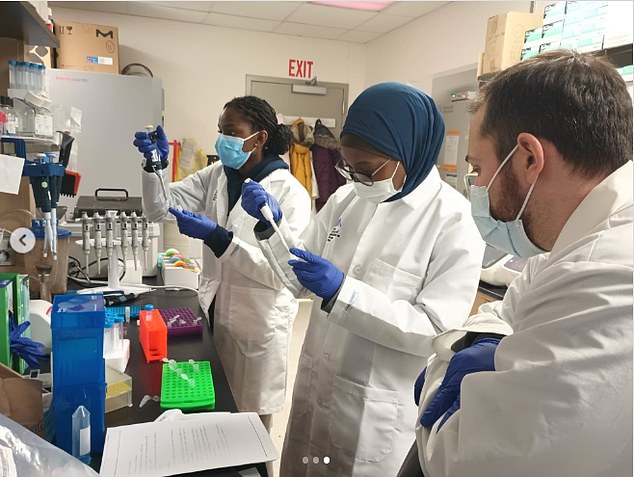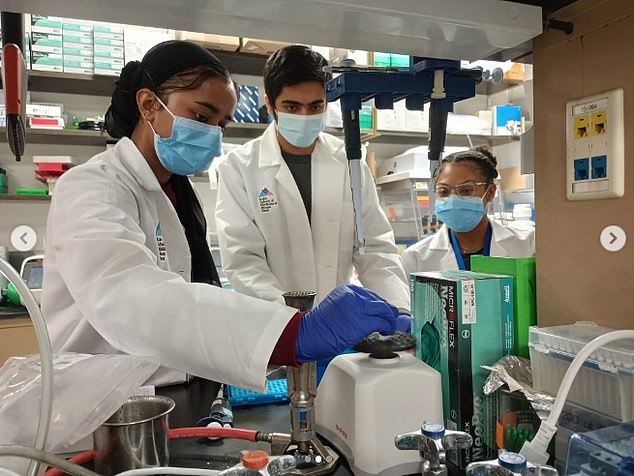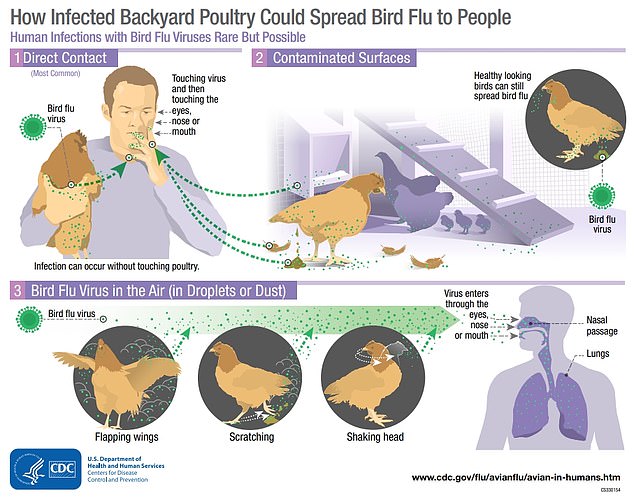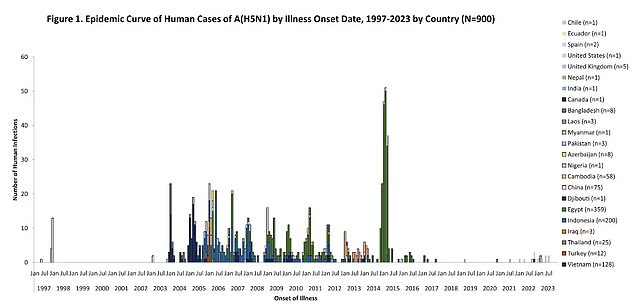High school students in NYC will hunt and study viruses spreading in birds to ‘prevent future pandemics’ – as part of $1.3m NIH program
Thousands of American high school students will become “virus detectives” as part of a government-sponsored program that hopes to help prevent the next pandemic.
The National Institutes of Health (NIH) has awarded $1.3 million to a Mount Sinai project to help teens find and study pathogens that could cause future outbreaks.
High school students from the five boroughs will collect bird droppings from parks with the aim of analyzing flu and other pathogens spreading among the city's bird population, but they will leave handling live viruses to expert scientists.
However, infectious disease experts have warned that the students could be at risk of becoming infected with a new pathogen if proper protective measures are not closely followed.
Students are pictured above collecting bird droppings as part of the 2022 phase of the program, which led to publications in scientific journals
A press release from Mount Sinai said the expansion of the virus hunting program “engages high school students from communities historically underrepresented in science in the first large-scale citizen science effort to catalog and map avian flu among the city's wild birds .
'The aim is to detect emerging viruses and prevent future outbreaks.'
As part of the program, students will scour New York City parks to find bird droppings and collect specimens that scientists can analyze for viruses in a lab.
The stool is collected using a large cotton swab to brush portions of the sample into a collection tube, which is then sealed until it reaches the laboratory.
During pick-up trips, students must wear a face mask and medical gloves to minimize the risk of exposure to pathogens.
Researchers said the students will not handle live viruses; these will only be extracted from feces for laboratory analysis by the scientists leading the project.
There are concerns about virus research following the Covid pandemic, which the FBI says was caused by a laboratory leak in Wuhan.

Pictured above are scientists analyzing samples in the laboratory to detect viruses

The bird droppings are analyzed for the presence of viruses or any new and emerging pathogens
The collection will take place at “large-scale” events, the program said, and students are advised not to come into contact with dead or live birds.
Also as part of the initiative, twenty teenagers will participate as paid Junior Research Scientist Interns.
They will work with scientists to screen collected samples and assist with sample testing and sequencing, and will be trained in general virology by expert mentors at Mount Sinai.
Although safety protocols have been put in place, Dr. Leonard Mermel, an infectious disease expert at Brown University in Rhode Island, warned that there was still a risk that someone could become infected from a sample collected.
He told DailyMail.com: 'This can pose a risk if students touch bird droppings and then touch their eyes, nose or mouth.
“If they wear goggles and a mask, that should reduce the risk of auto-inoculation.”
Autoinoculation is when a person transmits a disease from one part of their body to another, normally by touching the individual areas.
The latest NIH grant was awarded to Mount Sinai to expand its Virus Hunters program, which launched in New York City in September 2020.
The goal was to engage students in preparing for and preventing future pandemics.
The first phase of the program lasted two years.
The most recent grant is an expansion of the current program.
It was awarded in the midst of a major outbreak of bird flu with almost 4.6 million birds already slaughtered this year due to exposure to the virus.
An Ohio egg farm was the latest to discover the infection this week and said it will now have to slaughter its 2.6 million chickens.
The outbreak is largely caused by the H5N1 strain of bird flu, although the Centers for Disease Control and Prevention (CDC) SAID the risk to the public is “low.”
But the agency added that it is still possible for the virus to infect people if someone is exposed to large amounts of it through feces, bird litter or by touching birds.
There have been only four recorded human infections of H5N1 in the United States, the last of which was in April 2022 in an inmate working on a Colorado poultry farm.
But there are concerns that the H5N1 virus may become better at infecting humans as it has started infecting potential intermediate hosts including minks and seals.

The CDC says the risk of someone becoming infected with bird flu is “low.” The above image explains how someone can become infected by a domesticated chicken

The above graph shows human infections with H5N1 since 1997. There has been one case in the United States during this period, discovered in a poultry farm worker in April last year.
Announcing the program, Dr. Florian Krammer, a vaccinologist at Mount Sinai, said: 'Data generated during the pilot phase of the New York City Virus Hunters program has already resulted in peer-reviewed scientific publications and submissions of the first two avian paramyxoviruses that have ever been identified. in the city pigeons.
“This new, five-year grant will allow us to expand and broaden this citizen science initiative. We aim to recruit and support many more middle and high school students to participate in large-scale sampling events.
“This allows us to expand the number of biospecimens we can collect and analyze.”
The program is run through BioBus, a nonprofit science education organization known for its mobile labs that bring science to students. The organization partners with more than 800 schools and community organizations that primarily serve diverse student populations historically underrepresented in science, technology, engineering and math fields.
Dr. Christine Marizzi, a microbiologist at Mount Sinai, said: “Young people are smart and capable of making meaningful contributions to science if they have the opportunity to participate in our scientific community.
'Throughout the program, students build their own identities as scientists, gaining both a sense of belonging to the scientific community and valuable experience as they pursue further scientific education and careers.
“We are thrilled and grateful to be able to expand our program through this new grant so we can help even more young people participate in research that will make the Big Apple safer.”
